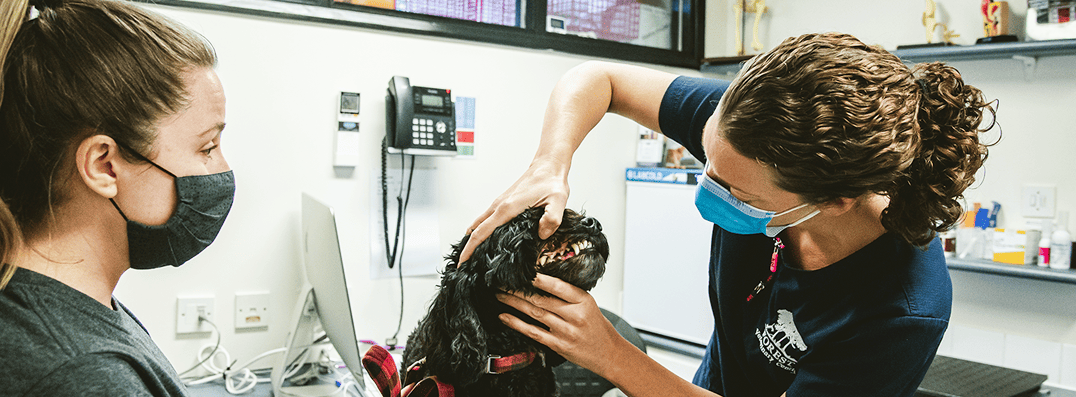Here at Forest Vets in Essex, we understand that your cat’s dental hygiene is just as important as any other routine and preventative treatment. This is why we recommend preventative dental care.
Like humans, cats can develop a build-up of tartar, which can lead to tooth decay and gum disease. Brushing your cat’s teeth once or twice a day is the best option for good oral hygiene. Here at Forest Vets in Essex, our team would be happy to assist you with answering any questions you may have, as well as advising you on the recommended products or dental diets for your cat.
Please contact Forest Vets in Essex, to book a dental appointment for your cat.
Symptoms of dental disease in cats
Cats can be very good at hiding signs of oral pain and dental disease. Some cats with severe dental disease, including broken teeth, root exposure, severe gingivitis (inflammation of the gums), resorptive lesions, and tooth root infections, will continue to eat and show only subtle signs that something is wrong.
While plaque can be removed by brushing, once there is a buildup of tartar, then this cannot be removed by teeth brushing alone; likewise, it is very difficult to clean the space underneath the gumline and into pockets between the teeth in our pets. The best action, if there are early signs of periodontal disease, is for your cat to have a Stage One dental procedure to de-scale and clean the teeth, perform a complete oral and dental examination, take a complete set of dental radiographs, and chart any abnormalities we detect. This will then be followed by tooth brushing to prevent the buildup from occurring again and reduce the chances of periodontal disease from progressing. However, left unchecked, periodontal disease can result in a cat needing to have multiple teeth extracted and sometimes more serious complications.
A general anaesthesia is required for all dental procedures, however, having several, short, Stage One dental procedures throughout our pet's lifetime can prevent the need for much longer anaesthetics and costly large-scale extractions especially when combined with ongoing at-home dental hygiene.
What are the signs of dental disease in cats?
- Bad breath (halitosis)
- Visible tartar buildup on teeth
- Red or inflamed gums (gingivitis)
- Discoloured teeth
- Drooling
- Loose teeth
- Bleeding from the mouth
- Slowness or reluctance to eat
- Chewing on one side of the mouth
- Dropping food from the mouth when eating
- Swelling around the mouth (from potential tooth root abscesses)
If you detect any of the above signs, please contact Forest Vets in Essex, to book an appointment for a vet to examine your cat as soon as possible.
Why does non-traumatic dental disease occur in cats?
Food, saliva, and oral bacteria combine to form a sticky substance called plaque on the tooth. Plaque is soft and can be removed by brushing or using alternative dental products. If not removed, the plaque will harden forming tartar, which is difficult to remove without dentistry intervention. Additionally, plaque will irritate the gums causing inflammation of the gums initially ('gingivitis') and as gingivitis progresses, there is an extension of the inflammation down to the tooth attachment structures ('periodontitis') and the progressive destruction of the tooth attachment structures is called periodontal disease. Gingivitis on its own can be reversible with good oral hygiene but periodontitis and periodontal disease are typically progressive so we want to avoid this if possible.
Cats also get another form of dental disease known as feline odontoclastic resorptive lesions (FORLs). It currently has an unknown cause, but 75% of cats are thought to be affected. It is particularly common in cats over five years but can occur at any age. In these lesions, part of the tooth is eaten away by the tooth itself, forming a small hole in the enamel close to the gum line. These lesions are very painful for cats and can lead to tooth fractures as they weaken the teeth. They require extraction to resolve.
How can dental disease in cats be prevented?
The best way to maintain healthy teeth is to brush your cat’s teeth daily. The Forest Vets' team would be happy to help with advice on introducing this to your cat.
It can also be beneficial to have a scale and polish performed regularly to clean the teeth thoroughly. This is similar to the treatment we would receive from a dental hygienist. These are done under a short general anaesthetic as cats won’t sit in one position for a prolonged period and we must ensure their safety and the team’s safety when in the vicinity of sharp teeth!
Feline odontoclastic resorptive lesions (FORLs)
Cats also get another form of dental disease known as feline odontoclastic resorptive lesions (FORLs). It has an unknown cause, but 75% of cats are thought to be affected. It is particularly common in cats over five years but can occur at any age.
In these lesions, part of the tooth is eaten away by the tooth itself, forming a small hole in the enamel close to the gum line. These lesions are very painful for cats and can lead to tooth fractures as they weaken the teeth. They require extraction to resolve.

